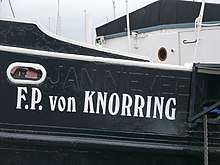F.P. von Knorring (ship)
.jpg) F.P. von Knorring in the eastern harbour of Mariehamn, Åland in 2018. | |
| History | |
|---|---|
| Name: |
|
| Owner: | Kim & Karin Harju-Jeanty |
| Builder: | Arnhemsche Scheepsbouw Maatschappij, Arnhem, the Netherlands |
| Cost: | 140,000 gulden |
| Laid down: | 1927 |
| Launched: | 1928 |
| Refit: | 1951 (steam engine replaced by diesel engine) |
| Status: | floating restaurant |
| General characteristics | |
| Tonnage: | |
| Length: | 45.40 m (148 ft 11 in) |
| Beam: | 6.73 m (22 ft 1 in) |
| Draught: |
|
| Decks: | 3 |
| Installed power: |
|
| Capacity: | 300 passengers |
| Notes: | website: http://www.fpvonknorring.com/ |
F.P. von Knorring, originally Jan Nieveen, is a passenger ship that was built in 1928 and that has been in use for a long time in the Netherlands. The ship is currently a floating restaurant in Mariehamn, the capital of the autonomous Finnish province of Åland. The ship is named after the beurtvaart shipper Jan Nieveen, who conducted transports from the city of Groningen to Lemmer.[2]
Built
The steamboat Jan Nieveen was built in 1927–1928 at the Arnhemsche Scheepsbouw Maatschappij shipyard in Arnhem, the Netherlands, at a then very high price of 140,000 Dutch guilders. It was ordered by the Groninger & Lemmer Stoomboot Maatschappij, a shipping line that had been founded in 1870 by three brothers: Reint, Jan and Geert Nieveen.[2] The ship was designed to have the maximum size that could pass the locks of Lemmer when fully loaded. The ship was taken into service for a regular passenger and freight beurtvaart connection over the Zuiderzee, between Lemmer and Amsterdam. Jan Nieveen had four sister ships but it was the flagship of the fleet.
In the 1930s, this ship line was a great success, but later, their importance diminished. The revenues lessened, and the vessel was used for recreational trips to the islands of Schokland and Urk, and along the coast as well.[3]
Second World War
During the Second World War, the ship got a vital function for transporting food from the northern Dutch provinces to Holland, in exchange for gold and silver. According to the orders of the German occupiers, it transported horses, while, on the lower deck, Jews in hiding were clandestinely smuggled to the relative freedom of the North-East Netherlands.[4]
Collision
During the Dutch famine of 1944–45, in the 8–9 January winter night, the ship was involved in a ship collision near the isle of Urk, with the sister ship Groningen IV of the same company. Thirteen passengers and crew of that ship drowned when the ship sank while they could not escape because the door had been blocked by the collision.[5] According to the German rules, the lights on both ships were dimmed, except for small navigation lights.[6] The Jan Nieveen was only slightly damaged.
Post-war: makeovers and renamings

Some years after the war, in 1951, the heavy steam engine was replaced by a much lighter, more modern diesel engine that had almost the same power.[7] The draught of the vessel diminished by 40 centimetres (16 in). A fusion between three beurtvaart companies in October 1953 had made a fleet of 34 ships, managed by the company J.H. van Swieten. Jan Nieveen and sister ship Harm Nieveen' were the show pieces of this fleet. The increasing competition by road transport made the era of beurtvaart come to an end. In 1959, the connection between Lemmer and Amsterdam was discontinued.
In 1958, the ship was sold and again it underwent several modifications. From 1961 to 1974 it served as a tourist boat in Rotterdam under the name of IJsselhaven, and then for two seasons in Biesbosch National Park named Wolga.[7]
In 1977, the Nieveen family bought the ship back, and renamed it to Jan Nieveen. The home town became Lemmer. From there, day trips were made to harbours around the IJsselmeer. Ten years later, the ship devotee Arthur Nikkessen from Amsterdam purchased the ship and he rebuilt it partially to the original state and he rented it out as a 'party-cruiseschip'.
To Åland

This lasted only for two years, and in 1989 the ship was sold to Dan Aalto and Ulf Danielsson from Åland.[8] They converted the ship to a restaurant ship, and since then it is in the eastern harbour of its capital Mariehamn. The ship was renamed F.P. von Knorring, after a vicar, teacher and founder of the first schools and the first newspaper of Åland: Frans Peter von Knorring (1792–1875).
In 2002, the restaurant went to the hands of the couple Kim and Karin Harju-Jeanty.
References
- ↑ (in Dutch) Vereniging 'De Binnenvaart': Jan Nieveen
- 1 2 (in Dutch) Spanvis: 'Jan Nieveen en de tramboten Lemmer-Amsterdam'
- ↑ (in Dutch) Spanvis: Jan Nieveen en de tramboten Lemmer-Amsterdam (2)
- ↑ (in Dutch) Spanvis: Jan Nieveen en de tramboten Lemmer-Amsterdam (3), quoting Nieuwsblad van het Noorden.
- ↑ (in Dutch) Spanvis: Jan Nieveen en de tramboten Lemmer-Amsterdam (4)
- ↑ (in Dutch) NRC: 'Spring meisje!' De Lemmerbootramp
- 1 2 (in Dutch) Spanvis: Jan Nieveen en de tramboten Lemmer-Amsterdam (5)
- ↑ (in Dutch) Spanvis: Jan Nieveen en de tramboten Lemmer-Amsterdam (6)
External links
| Wikimedia Commons has media related to Jan Nieveen. |
- (in Dutch) Vereniging 'De Binnenvaart', databank binnenvaartschepen: Jan Nieveen
- (in Dutch) binnenvaart.eu: Jan Nieveen
- (in Swedish) Restaurang F.P. Von Knorring – Jan Nieveens historia
Coordinates: 60°5′55.68″N 19°56′52.32″E / 60.0988000°N 19.9478667°E